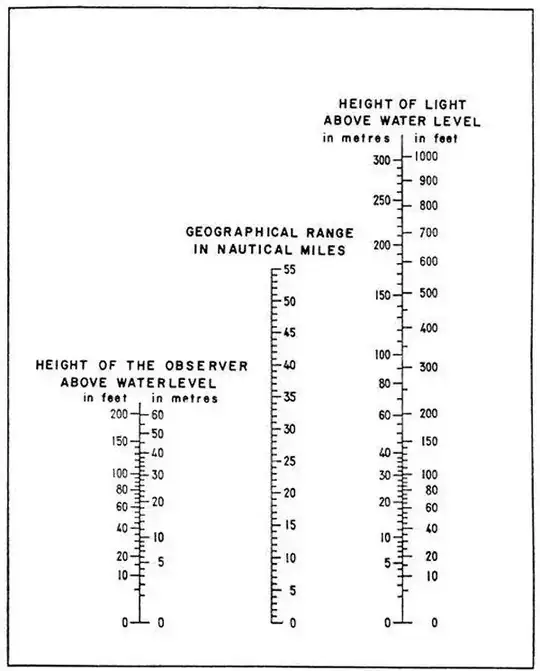Since Earth is a sphere, one has only a limited visibility radius. How far is that, actually?
This Q&A was inspired by this question, about whether or not Legolas can see the 24km distant Riders of Rohan.
Since Earth is a sphere, one has only a limited visibility radius. How far is that, actually?
This Q&A was inspired by this question, about whether or not Legolas can see the 24km distant Riders of Rohan.
I have up-voted the answer by M.Herzkamp, but I also think he makes it somewhat more complicated than it needs to be. The distance from the center of the earth to your eye is $r+h$, where $r$ is the radius of the earth and $h$ is the height of your eye above the ground. The distance from the center of the earth to a point on the horizon is $r$. The distance from your eye to the point on the horizon let us call $d$. The three sides of a right triangle are then the legs, $r$ and $d$, and the hypotenuse $r+h$. Applying the Pythagorean theorem, we have $$ r^2 + d^2 = (r+h)^2. $$ It follows that $$ d^2 = (r+h)^2 - r^2 $$ so $$ d=\sqrt{(r+h)^2-r^2}. $$ This admits simplifiction: $$ d=\sqrt{(r+h)^2-r^2} = \sqrt{(r^2+2rh+h^2) - r^2} = \sqrt{2rh + h^2}. $$ When $h$ is tiny compared to $r$, we can say $$ d \approx \sqrt{2rh\,{}}. $$
Let us suppose, an observer of height $h$ stands on a perfectly spherical planet of radius $r$:

Edit: here is an easier way, making use of the right angle between the line of sight and the radial ray. You can just use the definition of the cosine:
$$ \cos(\theta_T) = \frac{r}{r+h} \qquad \Rightarrow \qquad s = r\cdot\theta_T = r\cdot\cos^{-1}\!\!\left(\frac{r}{r+h}\right) $$
which is equivalent to the solution obtained by the complicated method. /Edit
The distance $s$ to the farthest point he can then see is determined by the tangent to the semi circle through his head. If you describe the semi circle in a cartesian coordinate system by $$ y^2+x^2 = r^2, $$ the observer's head is at $y=r+h,\ x=0$.
To obtain the slope of the tangent, we plug the tangent equation $y=mx+r+h$ into the circle equation and solve for $x$: $$ x_{1/2} = -(r+h)\frac{m}{1+m^2} \pm \sqrt{\frac{(r+h)^2m^2}{(1+m^2)^2}+\frac{r^2-b^2}{1+m^2}} $$ Those are two intersection points, and in order to have a tangent, they must be equal. That is the case, if the term under the square root is zero. The resulting equation can be solved for $m$: $$ m_{\pm} = \pm \sqrt{\frac{(r+h)^2}{r^2}-1} $$ Let's take the negative solution for the tangent on the right (it does not matter), and calculate the tangent point: $$ x_T = -(r+h)\frac{m_-}{1+m^2_-} = \frac{r}{r+h}\sqrt{(r+h)^2-r^2} $$ The viewing distance angle is $\theta_T = \text{asin}(x_T)$. To get the viewing distance, we observe that $$ \frac{s}{2\pi r} = \frac{\theta_T}{\text{full angle}} = \frac{\theta_T}{2\pi}\text{, with angle in radian} $$ $$ \Rightarrow s(h) = r\cdot\text{asin}\left(\sqrt{1-\frac{r^2}{(r+h)^2}}\right) $$ If you plot this for $h$ small compared to $r$, it resembles a square root function, and indeed, $$ \lim_{h\rightarrow0^+}\frac{s(h)}{\sqrt{h}} = \sqrt{2r} $$ which means that for small heights, the viewing distance can be described as $$ s(h) \approx \sqrt{2rh} $$ On Earth ($r\approx6371\text{km}$), a normal person ($h\approx1.8\text{m}$) can see the surface about 4.8km away. Not much further. If you climb a hill or tree ($h\approx 50\text{m}$), your range increases to 25km!
Atmospheric refraction cannot be neglected. As mentioned here the effect of this can be taken into account approximately by pretending as if the Earth's radius is larger by a factor of 7/6. This makes the distance $d$ to the horizon when the height $h$ is much less than the Earth's radius $R$ equal to
$$d = \sqrt{\frac{7}{3} R h}$$
If you go sailing, you'll have about 5 nautical miles of visibility (1nm = 1852m). I personally find the nomogram a delightful invention:

Simply draw a straight line between the height of the observer and the height of the object on the horizon (in this case = 0), then read off the geographical range.